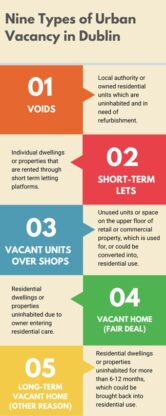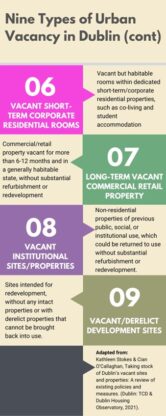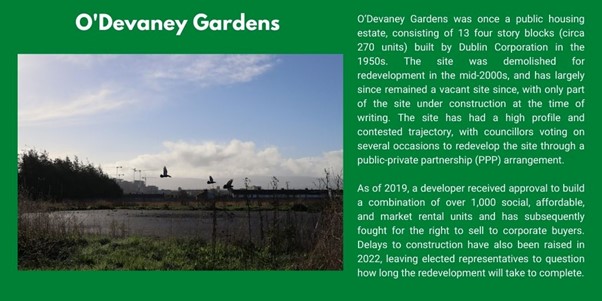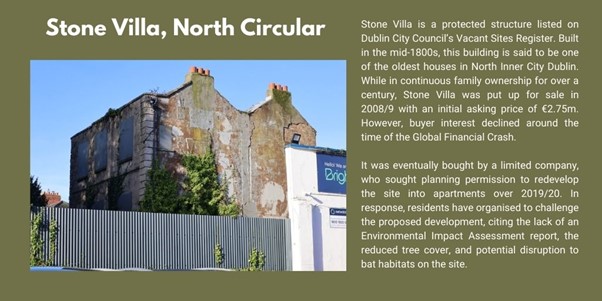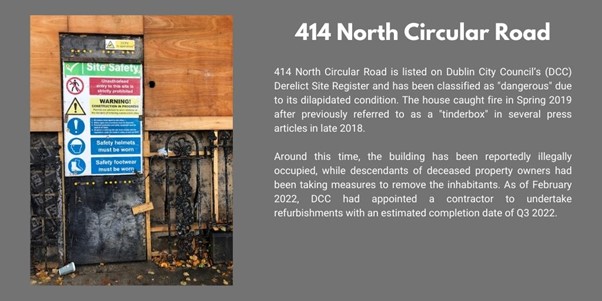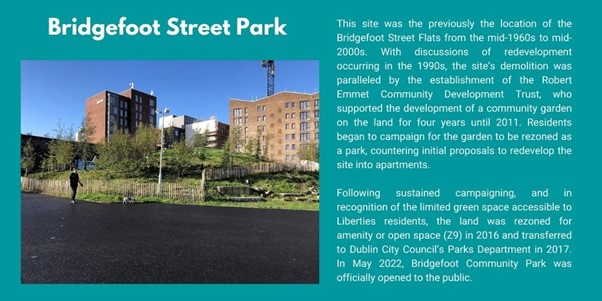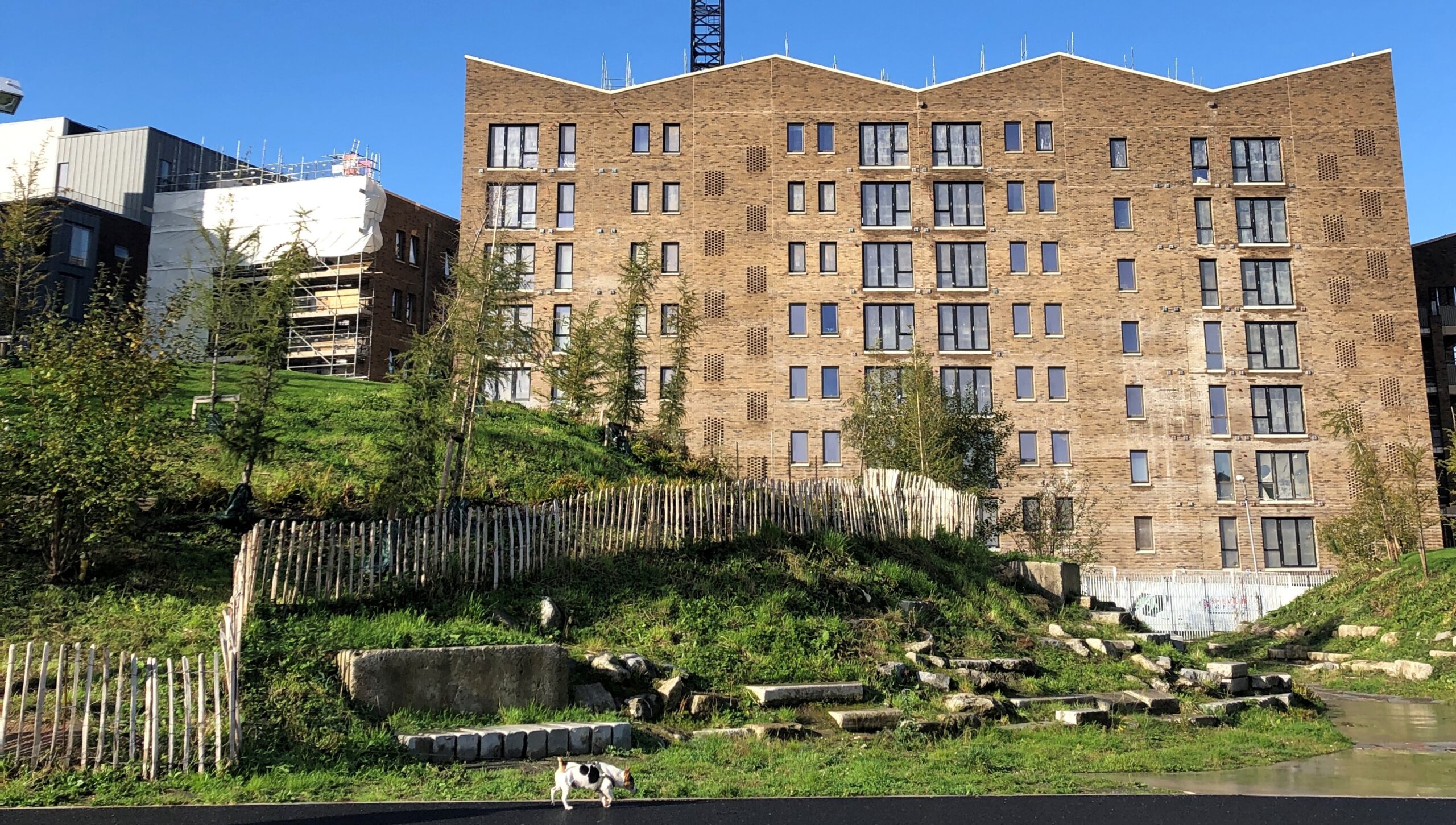
by Kathleen Stokes
Kathleen Stokes is a postdoctoral researcher in Human Geography at the University of Galway, whose recent publications include “What counts as infrastructural labour? Community action as waste work in South Africa” (2023) and “Taking stock of Dublin’s vacant sites and properties: A review of existing policies and measures” (2021).
Introduction
Housing vacancy and dereliction are commonplace features of all Irish cities and towns. We have rarely ventured far before we are confronted with an overgrown lot, an empty building, or a boarded-up house. In the backdrop of the country’s intensifying crisis of housing access and affordability, their existence generates much outrage and contention. Public opinion seems unanimous that something needs to be done quickly to return vacant and derelict sites back to use. However, what this means and what it entails is no foregone conclusion.
Housing policy is rarely straightforward, and in this case it is no different. Before settling on solutions, it is helpful to reflect on some important questions about the causes of vacancy and dereliction. Do we understand how such spaces come to be abandoned, uninhabited, and in gradual disrepair? What do we expect from these spaces that surround us – who should have access to them, for what uses, and who should be responsible for working towards such ends?
The theme of this edition of Working Notes is “Rehabilitation”, a term that combines two distinct meanings. First is habilitate, which stems from the Latin habitare, meaning to make fit, to inhabit, live, or dwell. The second aspect, re-signifies a return or doing something again. Brought together, rehabilitation has come to mean the return of something or someone to an original or improved state, condition, or life. It has been used to describe all manner of circumstances, from bodily recovery to ruined reputations to the built environment.
Rehabilitation is a helpful term for thinking through how vacancy and dereliction are currently perceived and responded to in Ireland. It suggests a return to some sort of use and signifies a call for living, inhabitation, wellbeing and dwelling without necessarily relying upon fixed or pre-existing norms. Rehabilitating vacancy and dereliction is not a standalone issue or a simple matter of “bringing things back into use.” To bring a space “back to life” there is a need to understand what it once was, how a space has come to its current material circumstances, who had a relationship with this space, and what the space might become given ideal circumstances.
In this essay, I want to think critically about how rehabilitating vacant buildings and space in Irish cities is more than a matter of construction. In what follows, I start by outlining how vacancy and dereliction are currently understood and responded to, before arguing for a more holistic approach to understanding their rehabilitation. Ultimately, my contribution moves from focusing solely on material conditions to reflect on the wider conditions surrounding vacancy’s production, persistence, and rehabilitation. This perspective, I argue, has the potential to contribute to more socially just approaches, responses and possibilities for vacancy.
Getting to grips with vacancy
Before we can think clearly about rehabilitating vacancy, it is vital to understand what it is (and isn’t). Much of Ireland’s public outrage over vacancy stems from the regular announcement of big numbers like the Census 2022 vacant dwelling figures,[1] or through sharing photos of individual sites or buildings in the press or social media, as with the #derelictIreland hashtag. While multiple datasets and registers capture different dimensions of vacancy and dereliction, current measures of vacancy and dereliction in Ireland only offer partial understandings and are based on different parameters and assumptions. For instance, a national statistic might give you an overarching figure but overlooks the more nuanced geographies of vacancy, and doesn’t specify what is habitable or could be returned to use with minimal cost and effort. Conversely, a picture may tell a thousand words, but it will not detail ownership information or the planning histories of a particular vacant site. Quantifying measures also don’t explain how vacancy has been produced, how long it has been present, and who or what has been involved in creating and maintaining it.
Part of the challenge here is in the discrepancy between how vacancy and dereliction are ordinarily understood (‘I can see it’s falling apart’, or ‘I know no one has lived there for years’) and how they are legally defined.
Most people identify vacancy and dereliction based on how something looks – whether it is run down, in poor condition, or unoccupied. While this is undoubtedly a quick way of spotting buildings and sites in need of attention, it excludes properties that might be vacant or derelict but don’t match these subjective aesthetic registers – perhaps not visible from street level or where exteriors are maintained. In some cases, a neighbour might mow the lawn of an adjacent vacant home to avoid it becoming an eyesore. Likewise, vacant units in apartment buildings can be especially difficult for anyone assessing vacancy from the street level.
Vacancy and dereliction are legally defined in precise yet different ways. In 1990, the Derelict Sites Act defined dereliction on the basis of a negative aesthetic quality that detracts from a surrounding area.[2] Meanwhile, the Urban Regeneration and Housing Act in 2015 only defines vacant sites as being over .05 hectares and must consist of residential land that is both suitable for housing where there is a need, or regeneration land that is negatively affecting the surrounding amenities.[3] These definitions are intended to set parameters for what can be included on local authority registers and, consequently, what actions local governments can take to enforce their reuse. However, these prescriptive definitions also exclude and lump together an incredibly diverse set of spaces, processes, and material conditions.
In our research, Cian O’Callaghan and I have argued that distinguishing between different types of vacancy (see figures 1 and 2 below) can help gain more precision in our debates and responses.[4] Vacant units over shops will be vacant for different reasons than large-scale derelict sites, and require distinct kinds of information, resources, and strategies to rehabilitate them. Vacancy and dereliction encompass a wide variety of material conditions, geographies, and processes and must be considered in relation to surrounding socio-economic conditions, infrastructural access, and needs of current inhabitants. For instance, according to GeoDirectory, vacancy and dereliction rates are considerably lower in Dublin and surrounds than in more rural counties.[5]
A single approach cannot be devised to ‘solve’ vacancy, but that doesn’t mean rehabilitation is out of reach. Increasing people’s awareness of vacancy and dereliction in their neighbourhoods is leading to increased public discussion over what can be done and who is responsible.
While useful, this approach often doesn’t get to the bottom of why vacancy has become so widespread and so prolonged in different settings, and what specific support and actions are needed to rehabilitate different spaces. Moving from decrying vacancy and dereliction as a general condition to questioning what forms are most prevalent, where, and why, can lead to more locally-informed, specific, and appropriate responses. Already this is beginning to happen with more targeted conversations around the particularities of vacancy in town centres, as with the Heritage Council’s Collaborative Town Centre Health Check, which brings together community groups, businesses, representatives, and residents to assess, work towards, and monitor the regeneration of their town centres, including vacant sites. [6]
In recent years, vacancy has risen as a key pillar within current government housing policy, yet the prescribed policy responses have done little to change vacancy rates or public concerns dramatically. Vacancy was a pillar of the 2017 national housing policy Rebuilding Ireland, which led to several key developments and policy responses, including interest-free loans for the renovation of vacant units into social housing,[7] and the creation of local authority Vacant Home Officers and vacant sites registers to keep track of vacancy and issue levies on vacant sites.[8] While some areas, such as Waterford, have leveraged the Repair and Lease scheme to increase their available social housing, most of these developments have had low take-up across the country.[9] Even when market incentives are available, the knowledge, resources, and capabilities needed to reduce vacancy and dereliction don’t appear to be coming together.
Despite the limited impact of early schemes, the current government continues to push similar incentive-based policies, including a grant of up to €50,000 to property owners for renovations to long-term vacant properties or self-building on vacant sites.[10] Budget 2023 announced a new ‘Vacant Homes Tax,’ which has already received critiques for being insufficient, or failing to learn from enforcement challenges and loopholes associated with the existing Vacant Sites and Derelict Sites Levies.[11] Amidst the current round of policy announcements, it is worthwhile taking a step back to consider what is practically needed to bring vacant and derelict sites into a habitable state and what is prohibiting such efforts. While vacancy and dereliction encompass a diverse set of material conditions, geographies, and histories, together they are illustrative of the myriad of exclusions and contradictions within our build environment. It is essential to consider the underlying conditions that have prevented rehabilitation on a wider scale thus far. Recent policy responses have focused more on incentivising existing market conditions over addressing the broader systems that underpin and enable widespread vacancy and dereliction in Ireland.
Practical matters
Spaces go through different uses, change hands, have periods of lowered and heightened activity, and experience uncertainty and transition.
Thinking that vacancy can be entirely eradicated once and for all suggests that all space should be productively in use at any given time, rather than considering what is desirable for a given place and whether all space is enfolded into human uses at any given time.
Homes might be empty while for sale or in probate, and a site might lie vacant for some time while different parties deliberate the best use for it. Or changes to a community’s size or makeup might mean that buildings’ original purposes are no longer relevant or needed. This is not inherently problematic.
However, let’s say you’ve found a vacant building in your area and have gained access to it to bring it back into use. This building has been in disrepair but is structurally intact so that you could convert it into housing. What happens next?
Rehabilitating a vacant or derelict property requires money, expertise, and materials. If the necessary upgrades and renovations are more than cosmetic, then obtaining planning approvals might also be necessary. This process can take time and inevitably limits what is legally possible with existing buildings and sites. Additional approvals will also be needed if you wish to use the building or site for a use not covered by its present land use zoning. Furthermore, rehabilitation projects must also pass fire safety checks and adhere to other planning safety standards. While this might seem self-evident, our research has highlighted how navigating all of these steps, checks and approvals can be complicated, opaque and time-consuming.[12] More creative and flexible approaches to planning could be introduced, but it can be risky for planners to deviate from current requirements and face potential liability if anything goes wrong.
There is also the issue of conservation and heritage. Suppose your building is considered a protected structure or historic building of interest. In that case, you will have to work with conservation planners and undergo additional assessments to ensure that your plans do not jeopardise your building’s architectural heritage. The conservation issue is fascinating since many people raise it as one of the reasons widespread vacancy and dereliction is such a travesty – that Ireland’s build heritage is gradually decaying and being lost forever. Interviews with government officials, property developers, and others involved in rehabilitating vacant buildings noted how conservation processes and protections add substantial cost, time, and energy that many might not be able or willing to take on. Some suggested that reducing the strictness of conservation planning requirements and expenses might be necessary to encourage their rehabilitation. As one interviewee mentioned to us, the very processes and provisions intended to preserve our built environment can end up discouraging people from undertaking rehabilitation projects, and result in prolonged decline and vacancy.
It is also important to talk about money. Materials and labour have costs, as does the expertise of agents, planners, architects, solicitors and others to navigate the process of bringing a building back into a habitable state. And let us not forget that purchasing a vacant or derelict site or a building is next to impossible without personal or institutional wealth, as renovation costs cannot be factored into mortgage costs. While recent government grants attempt to minimise this cost, anyone wishing to purchase and renovate a vacant or derelict property still needs to have substantial financial resources (be that personal savings, loans, or something else). Furthermore, other interviewees reported that financing for redeveloping vacant and derelict sites had become more constrained following the global financial crash, with banks expecting higher returns on investment. While this is beyond the scope of our research to confirm, it was interesting to hear private developers suggest that the State could be the one player able to finance the rehabilitation of vacant and derelict sites and properties without requiring such a high rate of returns on investment.
I highlight these issues to emphasise how rehabilitating vacancy and dereliction is often more complicated than we realise. Still, none of these factors are insurmountable and, indeed, finding pressure points and blockages within these intersecting systems can help to identify what intervention, and by which actors, would be most beneficial. Furthermore, rehabilitating vacancy is not limited to repair and renovation – while a crucial part of rehabilitation, it is more of a response than a rethinking of how such widespread and longstanding vacancy and dereliction have arisen in the first place. This leads us to question whether rehabilitation might also necessitate more fundamental transformations to understand, govern, and interact with the built environment and space in general.
Beyond vacancy: rethinking property, governance and space
Vacancy and dereliction is often equated with vandalism and waste, with commentators decrying it as a form of misuse and incompetence. However, public discussion rarely focuses on how different incentives and logics enable and encourage distinct forms of vacancy. Far from an isolated condition or spatial failure, vacancy is an inherent part of our built environment and economies. Leaving a building to become vacant or fall into dereliction can be a strategic stage in many urban development processes. A site might be kept vacant as the owner attempts to assemble a series of sites for a more considerable development or is waiting for approval to rezone the property. Similarly, expensive luxury apartments might be kept empty instead of reducing rents.[13] This might seem illogical to some, yet it is emblematic of our speculative, financialised land and housing markets.
Alternatively, longstanding vacancy sometimes persists because it is impossible to confirm and contact the property owner – they might be absentees who have fallen through the cracks of Ireland’s multiple registration systems, or ownership might be obfuscated through registration within shell companies. While strikingly different, both examples highlight the centrality of property rights within current concerns over vacancy in Ireland. On the one hand, this is implicit in public calls for owners to keep their properties in good and habitable conditions and public financial incentives for property owners to renovate and conserve their vacant and derelict buildings. The primacy of property rights is also implicit when occupiers are quickly (and sometimes violently) expelled from vacant and derelict sites, as seen in Dublin over the last year with the evictions of Sunnyvale Social Centre and Parkgate House/Ionad Sean Heuston, to name a few.
In addition to property rights, the role of State in addressing vacancy is also frequently called into question. The extent to which State actors should be responsible for direct intervention remains unclear, and dependent upon a broader distribution of governmental powers and capabilities. Presently, national policy and legislation have placed significant responsibility on local authorities for identifying and responding to vacancy and dereliction. While local governments can implement compulsory purchase orders, they are seen as a last resort and must compensate the owner at the market cost of the property. Yet compulsory purchase orders can be time-consuming and costly due to long appeal processes and inflated property values, which cannot be reduced to account for redevelopment or repair costs.
There are examples where local authorities have compulsorily purchased a vacant building and converted it to social housing. We can ask whether this process could be made more widespread, cost-effective, efficient, and accessible than simply building anew. For instance, one interviewee suggested giving more autonomy to local authorities devise strategies for working with owners to address instances of vacancy and dereliction, as well as the freedom to seize properties for less than market value when more collaborative options were not possible (so that finances could be leveraged to undertake repairs). While this might not be suitable for all instances, it highlights a generative interpretation of the State’s current role in urban development and in rehabilitating vacant and derelict properties.
However, rehabilitating vacancy should not be limited to pursuing any form of redevelopment or reuse for the sake of it. A more just approach to rehabilitation should also consider who gets a say regarding vacancy, and endeavour to reflect residents’ needs, desires, and visions for their built environment. For instance, activist occupations have transformed vacant buildings into community spaces and accommodation for unhoused people, creating temporary illustrations of alternative, socially-orientated potential uses of vacant spaces. Conversely, residents also voice refusal to proposed developments to vacant and derelict space through protest, petitions, or planning submissions. While these kinds of efforts reflect people’s desire to have a say in the future rehabilitation, most available efforts are also, by necessity, reactive. What if communities didn’t have to wait, but proactively could take on the vacant sites and buildings in their area or, at the very least, be involved in determining their best uses for their current and future needs?
To rehabilitate vacancy and dereliction in a just manner, we must reconsider how space is governed, valued, and inhabited in Ireland more generally. I don’t pretend this is an effortless endeavour that would be without risk or the potential for capture. Still, rehabilitating vacancy and dereliction should be thought of as more than a matter of a construction, given the limited success of such efforts to date. Instead, rehabilitating vacancy can be a starting point for determining what kinds of environments we wish to inhabit, with a view to devising opportunities that further democratise planning and our relationships to land and the build environment, encourage more proactive and socially-minded governance, and contribute towards more equitable and sustainable forms of spatial development, stewardship, and care.
To download a pdf of this essay click here


